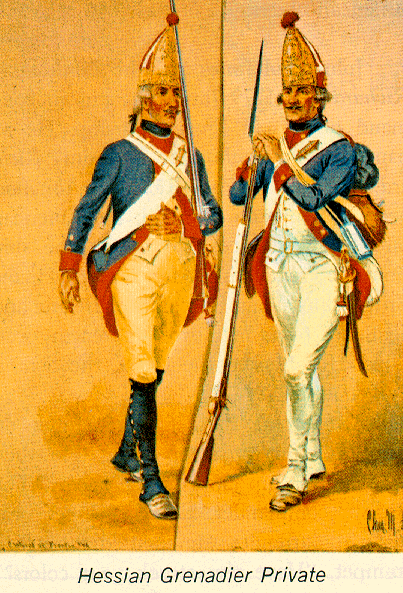Heinrich Meykranz (Maikrantz) a Hessian Grenadier
 Henrich
Meykranz (Maikrantz):
Henrich
Meykranz (Maikrantz):
Ransbach; Private; von Lengerke Reg., Co. 4; HETRINA Vol I;
Deserted at Mt. Holly, NJ 21 June 1778 and remained in
America.
As a grenadier Heinrich was the elite of the infantry. For one, a grenadier was taller than other soldiers, and generally was considered more intelligent. His musket was a heavy flintlock firearm. He was also fitted out with short-sword and bayonet. He was trained to use the bayonet on the end of his musket, being bayoneted seemed to have a more fearful effect on the Americans. His cartouche box and powder pouch were attached to his belt slung from the left shoulder to the right hip, and the firearms to slings crossing the belt.
In 1775 the American Colonies revolted, King George III of England's own troops were out numbered by the American rebels. He called for help from six German princes. Most were related to the King by blood or marriage and responded by supplying experienced troops to support the British.
A total of 30,000 German soldiers, the "Hessians", were shipped to North American shores. Nearly 6,000 of them remained permanently in Canada and the United States.
Hesse-Cassel supplied the largest number of troops by far. Approximately 17,000 soldiers were sent to America, representing about 1 out of 4 able-bodied men of military age of the population of that state. The Hesse-Cassel troops were considered superior to those of the other German states. They were well trained on the Prussian system and in good health. The treaty signed between George III and Frederick II, Landgrave of Hesse-Cassel, was a lucrative one for the German Prince. He would be paid an estimated 3,000,000 English Pounds over an eight-year period for the services of his army. It was also the 6th time in 100 years that the Landgrave of Hesse-Cassel had rented his troops. Thus the common soldier could hardly be considered a "mercenary". He received his regular soldiers pay from the Hessian army; the Landgrave received the benefit.
Hesse-Cassel sent 15 Infantry regiments; each consisting of 5 companies and the strength was 650 officers and men. Also sent were 4 Grenadier Battalions, 2 Yager companies and 2 Field Artillery Companies. Regiments were often named after their "Commander", but not always.
The Hesse-Cassel forces spent most of their time in the 13 Colonies. They arrived in New York in August 1776 and departed in August 1883. They participated in every major battle of the war, including the battle of Trenton where many were killed, wounded or captured in the American victory.

A map of Germany and it's territories during the time Heinrich would had been a Hession soldier.
HOME PAGE
© Copyright Mike Mygrant 2004-2005